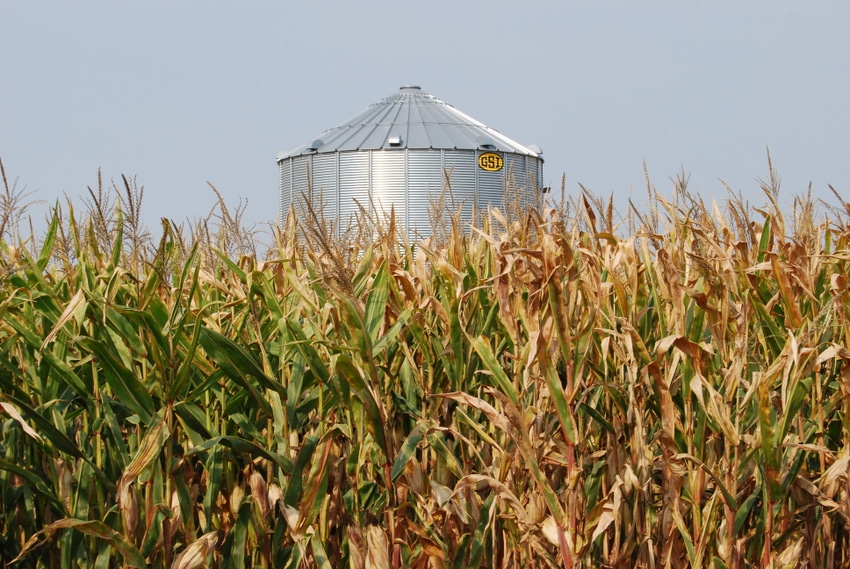
The early-harvested grain from this year’s corn crop so far is of high quality in Iowa. Grain moisture was a concern before harvest began, but with warmer temperatures in September, the grain started drying down more in the field. “When you have 85 to 90 degrees F or warmer, moisture doesn’t stay in the kernels very long on ears in the field,” notes Charlie Hurburgh, Iowa State University Extension grain quality specialist.
In the third week of September, he was hearing reports of corn coming out of the field with a grain moisture content of around 25%, and that will continue to go down. “At the end of harvest, this year’s crop will likely have an average moisture content that is about normal — say, 17% to 19%. That’s where the average will likely settle out. Also, considering test weight as an indicator of overall quality for storability, I think it will be pretty good.”
Grain storage: Out with old
So now, at the beginning of harvest, without a great deal of issues with the 2017 crop, it’s a good opportunity to rotate out your old-crop 2016 corn still in the bin. In a number of cases, stored corn from last fall’s harvest has had some trouble: mold problems.
“It’s a good idea to move old-crop corn out of storage and put the new crop in the bin,” says Hurburgh. “We know we have new grain that’s going to have to be stored into next year. I tell farmers, don’t mix the crop years. I know that’s extra work, but you should trade the old crop off. This year’s crop will be much better quality for storing than the 2016 crop.”
Problems with old crop still in bin
Problems with 2016 corn in storage trace back to last fall’s weather. “We had warm weather and relatively high humidity in fall 2016, which meant we didn’t get the grain cooled down, and we used up the shelf life of the corn in the bin,” says Hurburgh. “Now, showing up on the 2016 corn is blue-eye mold and other kinds of storage fungi, which won’t get any better during storage. There will be damaged kernels, and they will get worse — no matter what you do to them, such as aerating the grain, etc. It’s time to move that 2016 grain out.”
Adding new corn to old corn in a bin is risky, says Hurburgh. Inevitably, spoilage will start where those two grain crops meet. The old crop has sat around awhile and has pretty much a full load of mold spores and fungus. They may not have been actively growing, but are still present. “New-crop corn, even if it has been dried, isn’t totally stable,” he says. “Moisture is moving around within the kernel and the grain mass. You end up with trouble brewing where those two crops come together, and you will have problems. That’s why I say, ‘Don’t mix old- and new-crop grain in the same bin.’”
Install moisture, temperature monitors
Hurburgh acknowledges farmers are continually improving their grain management skills with on-farm storage. “There are fewer bins with no aeration fans, and grain dryer technology has improved and is producing a more uniform product,” he notes. “Those are positives.”
Still, there is a shortage of electric temperature monitoring systems in bins. “Couple that with the fact that bins are getting larger, which means farmers aren’t likely to climb them as much to check the condition of the grain. And besides, you can’t probe a large bin deep enough to get enough information. It is my plea to anyone building a bin to install grain temperature monitoring. The technology is available; we just need to be using more of these systems.”
Same advice for soybeans as for corn
What about soybeans? Same advice as for corn: Don’t mix old-crop and new-crop beans in the same bin. Now is the time to move the old crop, whether selling the grain or consolidating bins, to keep it separate from bushels in the field.
Farmers have several options to avoid comingling old- and new-crop grain. Besides selling grain, you can take old-crop corn from multiple bins to start fresh in as many storage bins as possible. Also, some farmers use old-crop corn or beans to satisfy new-crop delivery contracts during harvest to free up space. “This is risk management,” says Hurburgh. “Take your old-crop grain to the elevator and let them handle it.”
About the Author(s)
You May Also Like




